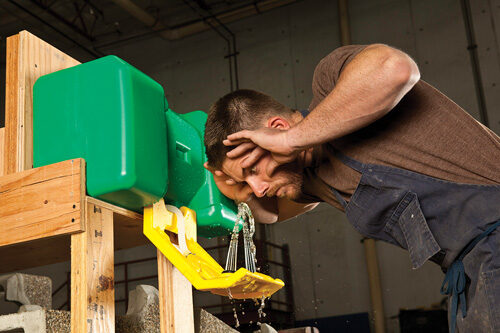Choosing an emergency eyewash/shower station
How do I know if I need a portable or plumbed emergency shower/eyewash product?

Responding is Samantha Hoch, product marketing specialist, Haws Corp., Sparks, NV.
OSHA’s 29 CFR 1910.151(c) states that “Where the eyes or body of any person may be exposed to injurious corrosive materials, suitable facilities for quick drenching or flushing of the eyes and body shall be provided within the work area for immediate emergency use.” OSHA turns to ANSI’s Z358.1-2014 standard for specifics on selection, installation, operation and maintenance requirements.
Proper emergency equipment selection is a function of knowing your risks, the characteristics of the materials you work with, and logical consideration of the variety of products and design configurations available.
Once you have determined that an emergency station is needed, you need to define whether a portable or plumbed station is most appropriate. A portable eyewash is a self-contained ANSI-compliant emergency response product that is needed for locations that have no access to water and that can be moved to meet a facility’s rapidly evolving needs. Various types of portable eyewashes are available, including gravity-fed, air-pressurized and personal squeeze bottles (reference ANSI Z358.1 “Supplemental Equipment/Personal Wash Units,” Section 8.1). Portable stations can provide added flexibility that is a benefit in today’s dynamic work settings.
A plumbed unit is just as it sounds – a permanent emergency response solution that is in a fixed location connected to a continuous source of potable water with sufficient flow and pressure for ANSI compliance and victim comfort.
ANSI Z358.1 requires that all emergency stations – portable or plumbed – must provide sufficient flow (flow rate depends on product type [i.e., eyewash vs. eye/face wash vs. shower]) for a minimum of 15 minutes. They are also required to be located within 10 seconds of the potential hazard. Supplemental eyewashes, such as personal squeeze bottles, are a useful solution while a victim is en route to primary equipment.
In addition to water source, ask yourself these questions when determining if a portable or plumbed unit is needed:
Does the potential hazard stay in the same location within the facility or is it mobile? If it is a static workstation, a plumbed unit is the recommended product choice and must be installed within 10 seconds of the hazard. If the hazard is mobile, such as at a construction site, a portable product is recommended and should be placed within 10 seconds of the hazard.
Does the location need tempered water (60-100° F/?16-38° C)? If the emergency fixture will be located in areas where the internal water temperature could drop below 60° F (16° C) or rise above 100° F (38° C), the water temperature will need to be regulated. Only a few manufacturers offer portable units with an option for tempered water, therefore a plumbed unit along with a tempering solution is the recommendation.
Maintenance of portable and plumbed units differ. As portable units hold stagnant water, they are required to be drained and refilled with potable water on a more frequent basis. Most eyewash manufacturers offer a sterile preservative that keeps the water for an average of three months. On a weekly basis, ANSI requires a visual inspection to take place to ensure the unit is full and clean. Regarding plumbed units, ANSI mandates a weekly activation requirement to verify proper operation and flush buildup that may have formed due to stagnant water in the piping and unit.
It is impossible to predict when an injury will harm a worker’s eyes, face or body, but it is possible to take proactive preventive measures by supplying the appropriate emergency response equipment for maximum victim comfort and response.
Post a comment to this article
Safety+Health welcomes comments that promote respectful dialogue. Please stay on topic. Comments that contain personal attacks, profanity or abusive language – or those aggressively promoting products or services – will be removed. We reserve the right to determine which comments violate our comment policy. (Anonymous comments are welcome; merely skip the “name” field in the comment box. An email address is required but will not be included with your comment.)

